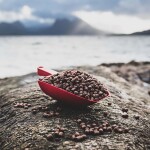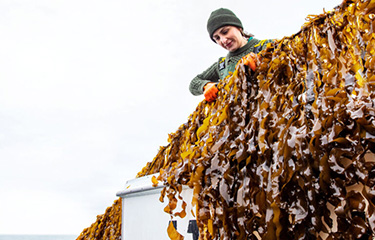Grown on the Pacific Coast from California to Alaska and on the East Coast in parts of New England, kelp has been harvested on a large scale in the United States since World War I, when the vegetation was used as a source of potash to make gunpowder. During that time, the harvest was unregulated and destructive to the surrounding habitats. Nowadays, the harvest of kelp is more sustainable due to harvesters only removing the upper portion of the canopy of the algae.
Today, the primary resource derived from kelp for human use is algin, a product used as a gelling agent in foods, pharmaceuticals, waterproof and fireproofing fabrics, a component in fertilizers, and an ingredient in food. In addition to this array of uses, kelp has been identified as a potential alternative energy source, according to NOAA Fisheries.
Studies on kelp forest ecosystems and the economics behind this sea plant show that it provides food and habitat for hundreds of fish species, invertebrates, and marine mammals. Additionally, healthy forests can protect coastlines and support other sustainable fisheries. Studies have shown that kelp generates a potential value of USD 465 billion to USD 562 billion (EUR 442 billion to EUR 535 billion) annually across three critical ecosystem services – fisheries production, nutrient cycling, and carbon removal.
Over the last 50 years though, climate change, deteriorating water quality, and overfishing have damaged 40 to 60 percent of U.S. kelp forests. The impact has been significant, as more than 95 percent of these forests have been lost in one section of the coastline from southern Oregon to northern California due to high temperatures and overharvesting. Small-scale fisheries have been severely affected by a lack of food as a result.
To help address these challenges, U.S. Senator Jeff Merkley (D-Oregon) created the Help Our Kelp Act, which will direct federal resources to support kelp forest recovery efforts. The bill would establish a new NOAA grant program to fund conservation, restoration, and management projects focused on kelp forest ecosystems. At a price tag of USD 5 million (EUR 4.8 million) annually through 2028, it would focus on addressing the most significant relative regional declines, long-term ecological or socioeconomic resilience, large-scale kelp forest loss prevention, or are in focal recovery areas identified by Tribal, federal, or state management plans.
Most remaining U.S. kelp forests today are located in marine protected areas, but some fishermen have turned to kelp farming both to earn additional income and as a means of reducing the pressure on the wild kelp population. These manually planted kelp farms have become a way to substitute the decline of forests. Water must be clear so sunlight can reach the suspended ropes and start the growth process from kelp spores to mature kelp. Kelp grows best in nutrient-rich, clear waters with temperatures between 42 to 72 degrees Fahrenheit. It is harvested once the kelp has developed over a few months.
Kelp farming is not just a way to benefit the income of these sea-farm fishermen, but also helps improve ocean health by reducing ocean acidification, according to Steve Train, a commercial fisherman in Maine who has been kelp farming for three seasons in addition to decades of fishing for lobster and scallops. The season for kelp farming in Maine is from late winter into the spring months, which is typically the offseason for commercial fishermen up and down the coast.
“It allows for a cash-positive flow at my slowest time of the year. It required much less of an investment than other options," Train said.
Train sells his kelp through Biddeford, Maine-based Atlantic Sea Farms, which helps fishermen get started building their farms, providing them with free seed and technical assistance to get farm leases, set up their gear, and learn how to harvest, and a multi-year contract for free seed and guaranteed purchase of kelp.
For Train, kelp farming has become a way to sustain income in what would typically be his offseason and a means of providing food for his family and local communities. He said he hopes more fishermen look into kelp farming, and that more people look to add kelp to their diets.
“If we can fill the consumer need for kelp through our farms, the harvest of kelp forests may not even be necessary,” he said.
Reporting by Carli Stewart
Photo courtesy of Atlantic Sea Farms







